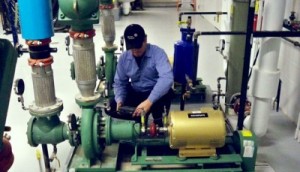Motor-Pump alignment is the process of aligning shaft centerlines between a motor and a pump. The motor is the prime mover, transferring power to the pump by the use of a coupling. This is probably the most common configuration of coupled machines in industry. (The 2010 U.S. industrial pump market is estimated by the Census Bureau to have been in excess of $4 billion)
In this type of alignment, the motor is almost always the moveable machine, and the pump is the stationary machine. In almost all cases, the pump is already piped up with suction and discharge flanges, which means it can move only slightly, if at all.
 Proper shaft alignment is achieved by moving the motor. The motor is shimmed vertically to achieve the proper elevation to align it to the pump, both parallel (offset) and angular. The motor is them moved horizontally to achieve proper horizontal placement for aligning the shaft centerlines, both parallel and angular. The motor is moved horizontally by the use of jacking bolts, or by the use of pry bars, hammers, or other tools.
Proper shaft alignment is achieved by moving the motor. The motor is shimmed vertically to achieve the proper elevation to align it to the pump, both parallel (offset) and angular. The motor is them moved horizontally to achieve proper horizontal placement for aligning the shaft centerlines, both parallel and angular. The motor is moved horizontally by the use of jacking bolts, or by the use of pry bars, hammers, or other tools.
Motors are normally easier to move, since the motor is not piped into a process system. A short run of flexible conduit is most often used to run the electrical wiring from a local disconnect, or a rigid conduit, to the motor termination box. This allows for ease of movement of the motor.
Motor-Pump alignment is critical for these reasons:
- It minimizes the forces of misalignment acting upon the bearings and seals of both components.
- It minimizes wear of the coupling.
- It can help reduce energy costs.
- It maximizes the life of the machine components by minimizing wear, increasing time between failures, and reducing vibration.
Motor-Pump alignment should be an important part of any maintenance program.


